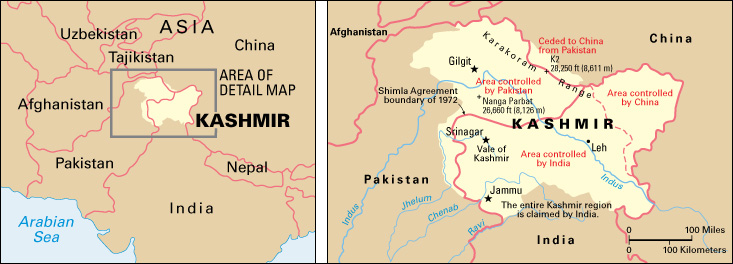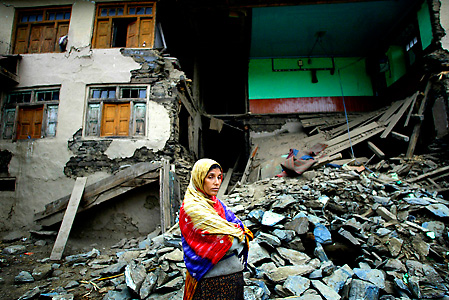Kashmir, << KASH mihr or kash MIHR, >> also spelled Cashmere, is a region in Asia controlled partly by India , partly by Pakistan , and partly by China . The region covers 85,806 square miles (222,236 square kilometers) in the Himalaya and the Karakoram mountains.
India and Pakistan have been locked in conflict over Kashmir since 1947, when the two countries became independent. India claims all of Kashmir, including all Pakistani- and Chinese-held areas. Pakistan claims all of Kashmir except the Chinese-held sections. The dispute has led to several Indian-Pakistani wars and other conflicts.

The name Kashmir comes from the region’s most heavily populated area, which is also called Kashmir. This area includes the Vale of Kashmir, which lies in the Indian-held section. The areas of Jammu and Ladakh, which have been considered part of the region of Kashmir historically, lie mainly or partly in the Indian-held section. Areas within the Pakistani-held section of Kashmir are administered as Azad Kashmir and Gilgit-Baltistan. China controls a part of Kashmir called Aksai Chin. Overall, India controls about 45 percent of Kashmir; Pakistan, about 35 percent; and China, about 20 percent. Two of the world’s highest peaks, K2 (28,250 feet, or 8,611 meters) and Nanga Parbat (26,660 feet, or 8,126 meters), are in Pakistani-held Kashmir. The Indus River flows northwest through Kashmir.
The people and their work.
About 12 1/2 million people live in the Indian-held areas of Kashmir, and about 31/2 million live in Pakistani-held Kashmir. Chinese-held Kashmir has virtually no permanent population. About three-fourths of Kashmir’s people are Muslims . Hindus are concentrated mainly in the Jammu area. Smaller numbers of Buddhists and Sikhs also live in Kashmir.
Most people in Kashmir farm for a living. Almost all the farmland lies in the Vale of Kashmir or in southwestern Jammu. Rice is the main crop. The area also has many fruit orchards. The Vale of Kashmir is famous for its saffron, an orange-yellow dye and food flavoring extracted from the purple autumn crocus (see Saffron ). Kashmir is also famous for its beautiful rugs and shawls made from silk and pashmina or cashmere wool (see Cashmere ).
History.
In 1846, the British colonial rulers of India gave control of the Vale of Kashmir to Gulab Singh, who was already king of Jammu and nearby areas. This action created the princely state of Jammu and Kashmir. Gulab Singh and his successors, all Hindus, governed Jammu and Kashmir, a Muslim-majority state, until 1947.
In 1947, the British left India, and two independent countries, India and Pakistan, were created. Rulers of princely states had to choose between joining India or Pakistan. But Kashmir’s ruler, Maharajah Hari Singh, delayed his decision. The issue became urgent after armed Muslim tribesmen from Pakistan invaded Kashmir. Forced to decide, Hari Singh made Kashmir part of India. Indian forces entered Kashmir to fight the invaders, who had been joined by Pakistani troops. The war continued until a cease-fire took effect on Jan. 1, 1949. The United Nations (UN) established a line dividing Kashmir between the two countries. But India and Pakistan each continued to claim the entire region. In 1962, Chinese troops seized part of eastern Kashmir.
In 1965, Pakistan invaded Indian-held Kashmir, but the war produced no territorial gains for Pakistan. In 1971, India and Pakistan again went to war in Kashmir, after India backed rebels in East Pakistan (now Bangladesh). The Shimla Agreement of 1972, which settled the conflict, established a border called the Line of Control between Indian-held and Pakistani-held parts of Kashmir.
In the late 1980’s, protests erupted in Indian-held Kashmir. Some protesters wanted Kashmir to join Pakistan, and others wanted independence for Kashmir. By 1990, the protests had developed into armed combat between guerrillas and Indian security forces. Since then, fighting has killed probably over 40,000 people.
In 1999, fighting broke out between India and Pakistan after Pakistani troops occupied the Kargil area on the Indian side of the Line of Control. A terrorist attack on India’s Parliament building in 2001 led India to build up forces along the Line of Control. Pakistan responded in kind, and the two countries came to the brink of war. The following year, international diplomacy eased the tensions.
In October 2005, a major earthquake hit north of the city of Islamabad in Pakistan. More than 73,000 people were killed in northern Pakistan and Pakistani-held Kashmir, and at least 1,400 were killed in Indian-held Kashmir. Over 3 million people were left homeless. Later In October, Indian and Pakistani officials agreed to open the border in five spots between Indian-held and Pakistani-held Kashmir to ease the flow of aid.
In 2019, the Parliament of India ended the special status that had allowed the state of Jammu and Kashmir—the Indian-held portion of Kashmir—to have more self-government than other Indian states. It reorganized the state as two union territories, Jammu and Kashmir in the west and Ladakh in the east. India’s federal government exercises more direct control over union territories than it does over states.

See also Hunza ; India, History of ; K2 ; Pakistan (History) .
